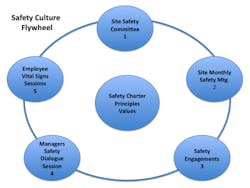Congratulations!
You made the decision and put in the long, hard, frustrating work. You cajoled and communicated incessantly to the naysayers, skeptics, and cynics. You might have even thought about quitting. You questioned, “Is this really worth it?”
But after many months, you’ve begun to see the results of your labor. The safety culture at your organization is shifting, and it looks like your vision, commitment, and persistence is paying off. You’ve got the new safety culture FLYWHEEL in motion!
Consider yourself very fortunate that your new culture is taking hold, because the history of long lasting change in organizations is dismal. Seventy percent of all organizational change efforts fail or only result in minor shifts. And yet, the reality usually is that if the organization doesn’t change, its capacity to avoid disruption or sustain itself will be compromised.
The question now is: How do I keep my new safety culture flywheel gaining in momentum?
The Flywheel
A flywheel is a rotating mechanical device that stores energy, helping to keep engines and other devices operating continuously and in the right direction.
When I say “safety culture flywheel,” think about how an actual flywheel operates. Flywheels have a significant amount of stored energy, or inertia, which enables them to resist changes in speed and direction.
This is what a safety culture flywheel does for an organization; it keeps everything moving in the right direction according to the values, beliefs and commitments you’ve determined to be essential to your success.
A culture of safety, like the inertia of a flywheel, provides stability and predictability, which all employees desire.
The Flywheel Effect
When an organization fails to accomplish long-lasting change, it’s because it didn’t put in place sufficient energy and direction to sustain the culture’s flywheel continuous motion.
Jim Collins, in his book Good to Great, describes what he labeled as “the flywheel effect.”
“The good to great companies understood a simple truth: Tremendous power exists in the fact of continued improvement and the delivery of results. Point to tangible accomplishments – however incremental at first – and show how these steps fit into the context of an overall concept that will work. When you do this in such a way that people see and ‘feel’ the buildup of momentum, they will line up with enthusiasm. We came to call this the flywheel effect.”
As Collins says, organizations don’t go from good to great because of one or two changes. It doesn’t happen “in one fell swoop,” or because of the inspiring words of a charismatic leader. “Laying down the law” in a command and control approach doesn’t work either.
Going from a good to great safety culture is a step-by-step cumulative process that consistently turns the flywheel in the right direction and builds the momentum to fully sustain the values, practices and attitudes of a great safety culture.
Case Study: Creating a Safety Culture Flywheel
In 2012, an organization I consult with was deeply concerned that their culture had contributed to incidents in which employees sustained serious and critical injuries. After an intensive process of reflection, they confronted the hard truth that their culture had indeed contributed to the injuries. They had to acknowledge, too, that if things didn’t change, the organization and its stakeholders would continue to be vulnerable.
The truth was that, although they espoused the “right” values on safety and hosted many safety programs, their organization failed safety culture and credibility tests. Employees knew from a lengthy history of decisions, disciplinary actions and rewards that safety took second place to production.
With this realization, the organization set out on a journey to change its culture to one that unequivocally established safety as its keystone value. The journey had its ups and downs, and as they took each successive step they found the resolve and courage to trust that by affirming safety as their keystone value they would be successful.
A critical step in the organization’s culture change process was the creation of a safety culture flywheel.
The flywheel consists of five pulse points, which consistently, transparently and generatively engage all employees. Companies that abide by the flywheel retain inertia, ensuring that a safety culture is embedded in the hearts and minds of all stakeholders. This is essential, as it is human energy and motivation that either moves the flywheel or restrains it from gaining the momentum required to create a robust safety culture.
Rules and procedures, and carrots and sticks, cannot sustain a safety culture. Employees at all levels must be intrinsically motivated to commit to procedures and to do the right thing when no one is looking.
That’s why each of the flywheel’s five pulse points addresses and incorporates three basic psychological needs: autonomy, relatedness, and competency. When met, these needs help to encourage, develop, and strengthen the intrinsic motivation necessary to sustain the momentum of a safety culture.
Flywheel Pulse Points:
1. Site Safety Committee: A multi-disciplinary group of employees who review feedback and input from Employee Vital Signs Sessions (5) and Safety Engagements (3). This committee establishes priorities and coordinates and implements policies to address safety concerns.
2. Site Monthly Safety Meeting: A site-wide community meeting held for the purpose of informing, updating, reviewing and communicating relevant site safety performance and quality information. In this meeting, managers should serve as role models, committed to the organization’s safety culture values and principles. A key function of the Monthly Safety meeting is to establish the “why” for upcoming activities, changes, priorities and expectations (that have been reviewed by the Site Safety Committee).
3. Safety Engagements: These small team/department meetings are designed to encourage discussions about safety topics. Assess employee engagement with safety protocols, listen to issues and concerns affecting safety performance and behavior and work to clarify policies and procedures that were identified as priorities or expectations in the Site Safety Meeting (2).
4. Managers Safety Dialogue Sessions: Site leaders and managers must embody the values of the safety culture; walking the talk is vital to maintaining trust and credibility as well as the viability of the safety culture. The dialogue session is a meeting and opportunity for managers to assess their commitment and accountability to the principles and values of the safety culture and to learn from each other’s experiences.
5. Employee Vital Signs Sessions: These meetings with employees are created for the express intent of soliciting and listening to their experiences, concerns, thoughts, and suggestions regarding the safety culture. Site managers and the Site Safety Committee (1) review the feedback from the sessions for appropriate responses and actions.
The Origin of the Flywheel Pulse Points
The safety culture flywheel’s five pulse points were developed intentionally to be analogous with the measurement of the strength and rhythm of one’s own heart.Culture is the accumulated beliefs, hopes, and goals of an organization, and safety is what should be at its heart. This is how I came up with a safety culture.
It is vital to routinely assess the health of your safety culture by checking its pulse. When organizations fail to do this, they operate absent critical data relevant to the health and wellness of their employees.
Don’t Take Off Without the Flywheel
If you want your hard work to pay dividends and if you want a return on your safety investments (ROS), make sure that your commitment, direction and focus is formalized in your safety culture flywheel.
Safety performance is first and foremost about culture. The catchiest slogans and best programs—event the noblest intent—cannot override the accumulated assumptions, habits, and beliefs of an organizations culture that purposefully or unintentionally relegates safety to the back seat. Safety must be elevated and positioned as the keystone value.
Safety performance is about human behavior, and the safety culture flywheel must address the factors that engage the hearts and minds of employees; it must tap into their intrinsic motivation. The flywheel that was presented in the case study was designed and developed based on the behavioral science of human needs that, when addressed properly, will engage employees to build and sustain the momentum of the safety culture flywheel.

